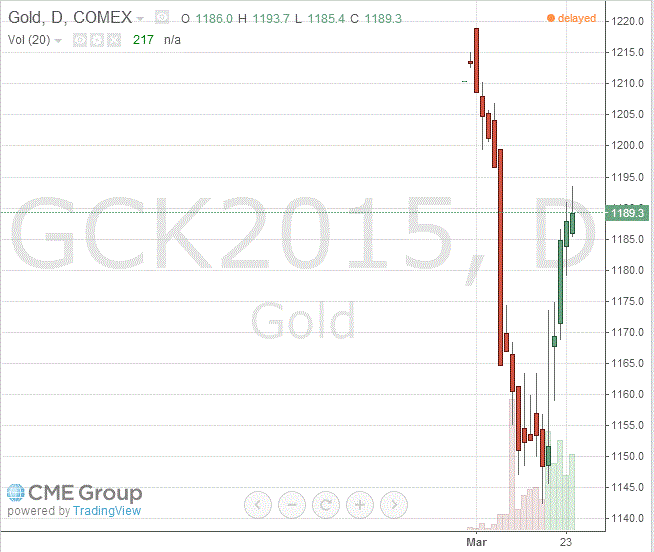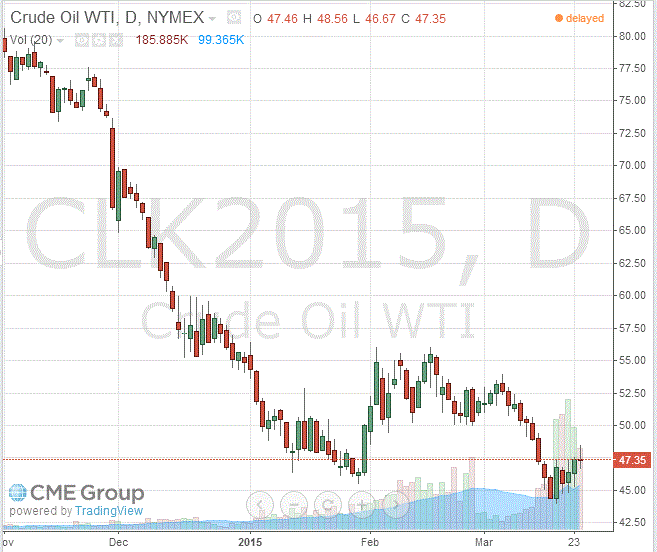Noticias del mercado
-
17:40
Oil: а review of the market situation
Prices for Brent crude oil fell slightly, due to the strengthening of the US dollar as well as concerns about the global oversupply. Meanwhile, the decline in the price of WTI crude oil is constrained by strong economic data in the USA.
Falling prices also associated with poor statistics on China. As it became known, in March manufacturing activity in China fell to 11-month low, as new orders declined. This suggests a weakening of the second largest economy in the world, which is likely to require easing to support growth. PMI PMI for the manufacturing of China from HSBC fell to 49.2 in March, which is below the mark of 50 points separating the increase in activity from the recession. Economists had forecast that the figure will be 50.5, that is, will be slightly weaker than in February, when the final PMI index was 50.7.
In addition, the pressure on the oil market continues to provide the words oil minister of Saudi Arabia, Ali al-Naimi that the country will produce 10 million barrels per day.
Market participants are also waiting for the publication of a report on energy reserves in the US last week. According to experts, the volume of oil reserves increased at the end of the 11th week in a row - to 4.75 million barrels. US crude stocks the previous week reached 458.5 million barrels - the maximum since the beginning of tracking this data by the Ministry of Energy in August 1982. "The market is starting to focus on data about the availability of facilities for the storage of oil, - analyst CMC Markets Michael McCarthy. - It is believed that the reduction in storage capacity over time takes its toll on production volumes."
"It is not yet started the summer driving season in the United States, the demand for fuel is reduced, and reserves in the country are growing," - said a senior analyst at Price Futures Group Phil Flynn.
May futures for US light crude oil WTI (Light Sweet Crude Oil) dropped to 47.35 dollars per barrel on the New York Mercantile Exchange.
May futures price for North Sea Brent crude oil mix fell 41 cents to 55.31 dollars a barrel on the London Stock Exchange ICE Futures Europe.
-
17:22
Gold: а review of the market situation
Gold prices retreated from a session high, and returned to the levels of the opening, which is associated with the strengthening of the dollar in response to strong US statistics.
The US currency showed mixed trends against the euro and the yen. As a result, gold briefly reached its highest level since March 6, 2015 - $ 1,194.5. "The dollar remains the main factor that affects the price of gold. Traders will closely follow the comments by the Fed to get hints about the timing of rate increases," - said the expert Naeem Aslam AvaTrade.
Today the head of the Federal Reserve Bank of St. Louis James Bullard said that zero interest rates are no longer suited the US economy, given the decline in the unemployment rate and the prospect of enhanced economic growth. Bullard said he expects the economic recovery in the 2nd quarter after a weak start to the year, as lower gasoline prices have supported consumer spending. He added that an early rate hike will help ensure that future Fed does not collide with the need to improve their faster to limit inflation. "If we do not begin to normalize policy now, two years later, we are very far behind," - he said.
At the same time on Monday, Deputy Chairman of the US Federal Reserve, Stanley Fischer, said that the rate may be increased in case of further improvement in the labor market, as well as sufficient confidence in the Fed that inflation will approach the target of 2%.
As for today's statistics, the Labor Department said that consumer prices in the US have resumed a modest rise last month after declining most of the winter, but core inflation remains weak against the backdrop of sluggish economic growth. The consumer price index, which reflects the fact that Americans pay for everything from food to medical care, increased a seasonally adjusted 0.2% in February compared with a month earlier. It was the first increase since October and the largest increase since June. With the exception of volatile food prices and energy prices, core prices also rose by 0.2%. Economists had expected growth of 0.2% of the total price and the increase in core prices by 0.1%.
Meanwhile, another report showed that new home sales rose to the highest level in the last seven years in February, becoming a sign of high demand, which can help improve the broader housing market in the United States. Sales of newly built, single-family homes rose by 7.8% compared to the previous month and reached a seasonally adjusted annual rate of 539,000, the Commerce Department said. This is the highest level since February 2008. Economists had expected sales to fall to 472 000. The figures for the previous month was revised up to 500,000 from the level of the initial value of 481 000. The sales are not recorded above $ 500,000, since the spring of 2008.
May futures for gold on the COMEX today rose by $ 1.3 - up to 1189.30 dollars per ounce.

-
12:20
Oil: prices reverse early losses after Chinese PMI on upbeat Eurozone PMI data
Oil is trading higher today, reversing early losses after better-than-expected PMI data from Germany and the whole Eurozone. The data showed first signs of the ECB's quantitative easing, it's massive bond-buying program worth 60 billion euro a month, is stimulating the economy and that the recovery is gathering momentum.
Early in the session prices were under pressure after the preliminary Chinese HSBC Manufacturing PMI for March came in at 49.2, an 11-month low, as new orders declined, fuelling fears of an economic slowdown of the world's second largest economy and the second largest consumer of oil.
Later in the day the American Petroleum Institute will report Crude Oil Inventories. As of last week U.S. stockpiles are at a record level - the highest since recording starte 80 years ago.
Brent Crude added +0.52% and trading above USD55 again, currently trading at USD56.21 a barrel. On January 13th Crude set a low at USD45.19. West Texas Intermediate gained +0.72% currently quoted at USD47.79.
Oil prices declined sharply in recent months as worldwide supply exceeds demand in a period of low global economic growth, pushing stockpiles to record highs and weighing on prices.
-
12:00
Gold adds gains for the fifth session – trades above USD1,190
Gold is trading higher today adding gains for the fifth consecutive session - supported by a broadly weaker greenback. Last week bullion added the most in one week since the January 2015.Now all eyes are on U.S. inflation data due today at 12:30 GMT.
The somehow dovish FED statement still lends some support to the precious metal and ongoing uncertainty over the Greek bailout and its future in the Eurozone add to bullish investor's sentiment. Yesterday ECB president Mario Draghi said in a statement that there is an acceleration of economic growth in the eurozone amid falling oil prices, improvements in external demand, easing financial conditions in the current course of monetary policy, as well as the weakening of the euro.
Recently a strong U.S. dollar and the prospect for higher U.S. rates weighed on the precious metal - as gold is dollar-denominated and not yield-bearing. Now, after the FED removed the 'patient' wording but giving a more dovish outlook on inflation and growth and the greenback is trading lower, gold finds some support.
Gold is currently quoted at USD1,193.80, +0,40% a troy ounce. On Thursday the 22nd of January gold reached a five-month high at USD1,307.40. On Tuesday last week gold traded as low as USD1,142.50, a three-month low.
-
10:20
Press Review: Greece promises list of reforms by Monday to unlock cash
BLOOMBERG
Analyst Predicts Apple Will Hit a $1 Trillion Market Cap
As Apple gets ready to launch its first new product in five years, Cantor Fitzgerald is raising its price target to a level that would make Apple a $1 trillion company.
People first started talking seriously about the potential for Apple to become a trillion dollar company in February when shares reached new highs, surpassing the $700 billion market cap level. The current stock price of $127 a share gives the company a valuation of $744 billion. Cantor analyst Brian White currently has the highest price target on Wall Street.
REUTERS
Greece promises list of reforms by Monday to unlock cash(Reuters) - Greece said it will present a package of reforms to its euro zone partners by next Monday in hope of unlocking aid to help it deal with a cash crunch and avoid default.
"It will be done at the latest by Monday," government spokesman Gabriel Sakellaridis told Mega TV.
Greece's left-wing government and its euro zone creditors agreed last week that Athens would come up with a list of its own reforms, which must achieve a similar budget impact to measures agreed by the previous conservative-led administration.
Athens is rushing to get the list ready before state coffers run empty, which is expected to happen in a few weeks without more aid.
Source: http://www.reuters.com/article/2015/03/24/us-eurozone-greece-reforms-idUSKBN0MK0F420150324
BLOOMBERG
Iran Could Add Million More Barrels a Day to the Oil Glut
(Bloomberg) -- Iran says it could add a million barrels to daily oil production shortly after a deal to lift sanctions, reclaiming the position of OPEC's second-largest supplier. While such a boost would take months because sanctions may be rolled back slowly, industry observers agree the capacity is there.
Going further than that and adding a second million barrels -- as the government has said it plans to do -- will prove a much bigger challenge. It would take some five years and tens of billions of dollars of investment, according to two former oil-industry executives who worked in the country.
"The number one need is investment," said Mohsen Shoar, an analyst with Continental Energy DMCC in Dubai who helped ConocoPhillips negotiate oil contracts in Iran in the 1990s. "To get anywhere beyond 4 million barrels a day" will require foreign assistance, he said by phone.
-
00:32
Commodities. Daily history for Mar 23’2015:
(raw materials / closing price /% change)
Oil 47.45 +1.89%
Gold 1,189.00 +0.11%
-

